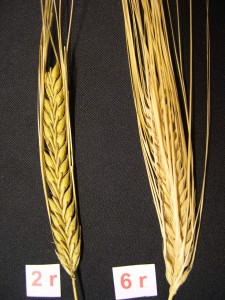
Barley with two rows of grain (left) and six rows (right). Public domain photo by Xianmin Chang via wikipedia.
After shunning the grasses in 2009 and 2010, the Joint Genome Institute of the US Department of Energy is making up for lost time with their latest set of genome sequencing announcements. There’s probably some organism that will excite anyone on that list, but let me tell you the one that excites me:
JGI is going to sequence the genome of barley (Hordeum vulgare), a reasonably close relative of wheat, an important crop in its own right, and a monster genome (though not as much of a monster as wheat itself).
Barley will be the fourth grass genome sequenced by JGI and the sixth grass genome sequenced in total (baring any secretive grass genome projects I don’t know about, a very real possibility). On the other hand, the barley genome is more than three times bigger than the combined size of all three grasses sequenced by JGI previously. Heck, at five gigabases it’s more than twice the size of the maize genome (one of two grass species, along with rice, sequenced by someone other than JGI)!
Now I assume that, like maize (or humans for that matter), a huge percentage of the barley genome is composed of transposons. I don’t know how JGI plans to handle assembling the genome, but I assume they’re be relaying heavily on the genetic maps developed by the barley community.
If you’re wondering how long it’ll be before this genome becomes available, consider this time-line of previous grass genomes sequenced by JGI:
- Sorghum bicolor: ~700 megabases
- Announced as part of the CSP 2006 program
- Published January 2009
- Brachypodium distachyon: ~275 megabases
- Announced as part of the CSP 2007 program
- Published February 2010
- Setaria italica (Foxtail millet): ~515 megabases
- Announced as part of the CSP 2008 program
- Published: Not yet
- Hordeum vulgare (Barley) ~5,000 megabases
- Announced as part of the CSP 2011 program
- Based on previous time lines expect to see a paper on this genome in early 2014*
So does this announcement have any bearing on my own research? Absolutely not. Even if the barley genome isn’t slowed down at all by representing more total sequence than all previously sequenced grass genomes to date (~4,000 megabases for rice, sorghum, maize, brachypodium, and setaria combined), it still won’t come out until after I’ve hopefully graduated. Does that fact make me any less excited to know it’s getting sequenced? (Or envious of the people who will get to play with the genome before its published?)
Not on your life!
*Estimated based on extrapolation from exactly 2 datapoints so don’t put too much faith in the estimate. If the foxtail millet genome is published early next spring, that will increase to three datapoints.
